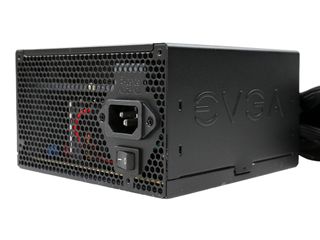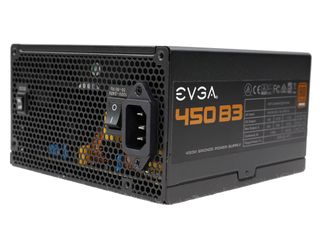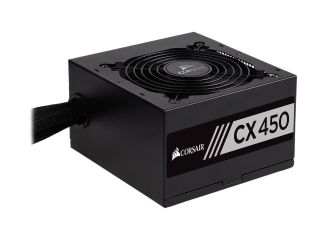EVGA 450 BT PSU Review: Amazing Value At $25
Why you can trust Tom's Hardware
Load Regulation, Hold-Up Time & Inrush Current
To learn more about our PSU tests and methodology, please check out How We Test Power Supply Units.
Primary Rails And 5VSB Load Regulation
Load Regulation testing is detailed here.








Hold-Up Time
Our hold-up time tests are described in detail here.







The hold-up time we measured is much lower than the 17ms we wanted to see. At least EVGA's power-good signal was accurate.
Inrush Current
For details on our inrush current testing, please click here.


Observed inrush current was high under 115V and 230V inputs. Obviously, the NTC thermistor is too small.
Load Regulation And Efficiency Measurements
The first set of tests reveals the stability of the voltage rails and the PSU’s efficiency. The applied load equals (approximately) 10 to 110 percent of the PSU's maximum load in increments of 10 percentage points.
We conducted two additional tests. During the first, we stressed the two minor rails (5V and 3.3V) with a high load, while the load at +12V was only 0.1A. This test reveals whether a PSU is compatible with Intel's C6/C7 sleep states or not. In the second test, we determined the maximum load the +12V rail could handle with minimal load on the minor rails.
| Test # | 12V | 5V | 3.3V | 5VSB | DC/AC (Watts) | Efficiency | Fan Speed | PSU Noise | Temps (In/Out) | PF/AC Volts |
|---|---|---|---|---|---|---|---|---|---|---|
| 1 | 1.941A | 1.969A | 1.974A | 0.975A | 44.757 | 77.194% | 1090 RPM | 26.9 dB(A) | 32.03°C | 0.688 |
| 11.939V | 5.077V | 3.337V | 5.127V | 57.980 | 36.05°C | 115.32V | ||||
| 2 | 4.891A | 2.956A | 2.967A | 1.172A | 89.294 | 83.015% | 1282 RPM | 33.2 dB(A) | 32.74°C | 0.870 |
| 11.940V | 5.074V | 3.336V | 5.119V | 107.564 | 37.21°C | 115.26V | ||||
| 3 | 8.254A | 3.446A | 3.448A | 1.370A | 134.418 | 85.044% | 1405 RPM | 34.9 dB(A) | 33.19°C | 0.961 |
| 11.923V | 5.080V | 3.335V | 5.110V | 158.057 | 38.14°C | 115.20V | ||||
| 4 | 11.628A | 3.934A | 3.960A | 1.568A | 179.647 | 85.522% | 1460 RPM | 35.7 dB(A) | 33.84°C | 0.965 |
| 11.906V | 5.085V | 3.333V | 5.102V | 210.060 | 39.61°C | 115.14V | ||||
| 5 | 14.646A | 4.922A | 4.950A | 1.767A | 224.945 | 85.417% | 1548 RPM | 38.3 dB(A) | 34.52°C | 0.978 |
| 11.911V | 5.080V | 3.332V | 5.093V | 263.348 | 41.34°C | 115.08V | ||||
| 6 | 17.593A | 5.913A | 5.946A | 1.967A | 269.444 | 85.130% | 1680 RPM | 39.8 dB(A) | 35.59°C | 0.986 |
| 11.916V | 5.074V | 3.330V | 5.085V | 316.508 | 42.99°C | 115.11V | ||||
| 7 | 20.609A | 6.904A | 6.940A | 2.167A | 314.747 | 84.589% | 1715 RPM | 41.1 dB(A) | 36.43°C | 0.990 |
| 11.919V | 5.070V | 3.329V | 5.077V | 372.091 | 45.35°C | 115.04V | ||||
| 8 | 23.624A | 7.895A | 7.934A | 2.368A | 360.086 | 83.829% | 1795 RPM | 41.6 dB(A) | 37.69°C | 0.993 |
| 11.924V | 5.066V | 3.327V | 5.068V | 429.547 | 48.29°C | 114.97V | ||||
| 9 | 27.081A | 8.381A | 8.417A | 2.369A | 404.988 | 83.079% | 1807 RPM | 41.7 dB(A) | 38.62°C | 0.995 |
| 11.908V | 5.072V | 3.326V | 5.067V | 487.471 | 50.41°C | 114.89V | ||||
| 10 | 30.474A | 8.866A | 8.933A | 2.470A | 449.704 | 82.096% | 1825 RPM | 41.9 dB(A) | 39.12°C | 0.996 |
| 11.895V | 5.077V | 3.325V | 5.061V | 547.778 | 53.91°C | 114.92V | ||||
| 11 | 34.307A | 8.850A | 8.936A | 2.471A | 494.510 | 81.313% | 1800 RPM | 41.7 dB(A) | 39.63°C | 0.997 |
| 11.872V | 5.086V | 3.324V | 5.060V | 608.154 | 55.15°C | 114.85V | ||||
| CL1 | 0.139A | 11.000A | 11.000A | 0.000A | 91.767 | 77.046% | 1765 RPM | 41.5 dB(A) | 36.59°C | 0.924 |
| 12.388V | 4.850V | 3.336V | 5.151V | 119.107 | 44.14°C | 115.24V | ||||
| CL2 | 35.003A | 1.002A | 1.000A | 1.000A | 416.574 | 82.744% | 1740 RPM | 41.3 dB(A) | 38.67°C | 0.995 |
| 11.509V | 5.275V | 3.327V | 5.112V | 503.449 | 51.99°C | 114.88V |
Load regulation on the +12V rail was tight, and the same went for the other three rails as well. The PSU's low capacity helped this, as did the fact that we don't take the CL1 load regulation results into account.
Notice that, during the eleventh test, the fan's speed dropped. This was due to the +12V rail's notably lower voltage compared to our full load test. Since that rail powers the fan's control circuit, it is normal to see a small reduction in speed. Regardless, EVGA's fan profile is quite aggressive, just as we'd anticipate from a low-efficiency PSU.
The 450 BT satisfied the 80 PLUS Bronze requirements, even at the high operating temperatures that we used for benchmarking. Since EVGA only rates this unit at 30°C, we didn't exceed 40°C during our tests.
MORE: Best Power Supplies
MORE: How We Test Power Supplies
MORE: All Power Supply Content
Current page: Load Regulation, Hold-Up Time & Inrush Current
Prev Page Teardown & Component Analysis Next Page Efficiency, Temperature & NoiseStay On the Cutting Edge: Get the Tom's Hardware Newsletter
Join the experts who read Tom's Hardware for the inside track on enthusiast PC tech news — and have for over 25 years. We'll send breaking news and in-depth reviews of CPUs, GPUs, AI, maker hardware and more straight to your inbox.
Aris Mpitziopoulos is a Contributing Editor at Tom's Hardware US, covering PSUs.

Sabrent debuts 5GB/s Rocket Nano 2242 Gen 4 SSD — a good fit for Lenovo Legion Go, laptops, and NUCs

AMD takes CPU market share from Intel in desktops and servers, but Intel fights back in laptops

Stack Overflow bans users en masse for rebelling against OpenAI partnership — users banned for deleting answers to prevent them being used to train ChatGPT
-
Onus This looks like a decent choice for a business-class PC, or even a light gamer, which probably won't pull more than half its rated output.Reply -
chimera201 Could you measure hold up at lower loads(20%, 50%, etc)?Reply
And why isn't inrush results included in cybenetics database?
Normally "S" is considered higher than "A++" -
Aris_Mp S stands for standard. As for the hold-up time, it is measured only in the worst case scenario, which is full load. Unfortunately there is no time to take extra measurements, especially since we want to implement some other tests.Reply
About the inrush current, Cyben''s pdf report covers only the basic in order to be kept at a normal size. -
chimera201 Just curious how the values for hold up would look like at lower loads (I know it's higher). If you do plan on testing it even once at-least do it on a cheaper PSU unit. Testing it on a higher-end unit would defeat the purpose.Reply
And I thought Cybenetics was supposed to give a detailed report. Not including inrush results, etc kind of defeats the purpose. -
Aris_Mp The main role of Cybenetics is to provide efficiency and noise certifications. The extra results are just to let people know a little more about a PSU's quality. If Cyben provided everything then it would be a review and not a certification.Reply -
HERETIC-1 Quality,low power PSU's are hard to find-Reason-Quality components cost money.Reply
PSU IS THE MOST IMPORTANT PART OF ANY BUILD.....................
RECOMENDED-
Seasonic G360 or G450
Corsair SF450 -
Marlin Schwanke Read the list of cons again. This thing is junk. There is no such thing as a decent $25 power supply.Reply -
fry178 so more cons than pros, calling it decent build quality when almost all cons are related to quality.Reply
lol.
less respect with every review like this.. -
Aris_Mp Every product is judged based on its price.Reply
"Almost all cons are related to quality". Actually two our of the six have to do, in a degree, with build quality. Thin cables and overated MOV. Transient response, lower hold-up time, noise and old platform are not build quality related. Build quality has to do with the quality of the components and the craftsmanship unless you imply/understand something else.
You know what I also call decent build quality? A PSU that has a 25C rating and manages to finish all of my tests at much higher ambient temperatures. If its components were crappy then it wouldn't even last a minute under the overload tests, as many other PSUs that have died in my hands so far. -
fry178 cables are still components.Reply
and as well as everything else, it's still directly/indirectly related to quality, no matter if physical parts or design/engineering.
especially since this isnt a box sold by a 12y living in the grandparents basement.
i dont expect a semi modular unit with a 140mm silent fan on this, but i doubt lots of ppl would consider this type of "quality" product, if it was anything else they are using, not even talking about the fact its a name brand that sells very good units.
when did it start to be ok for a product to have more cons than pros?...
doesnt make any sense to me to call it "amazing value".
but i guess thats just me.


